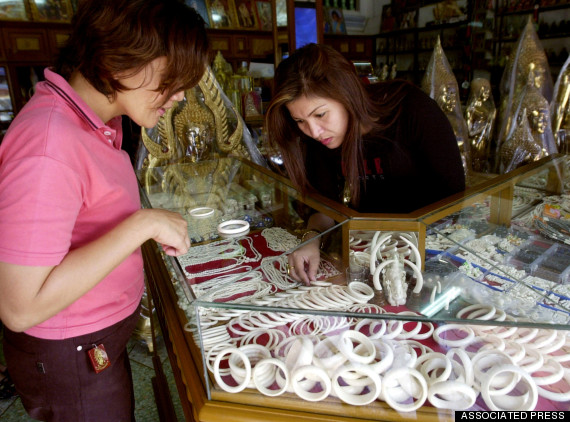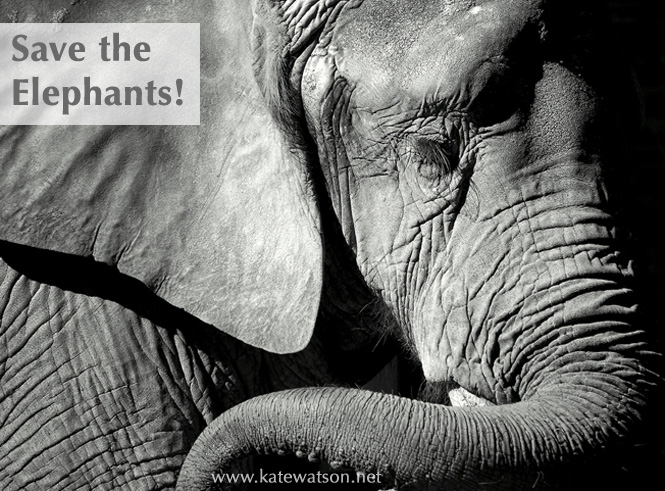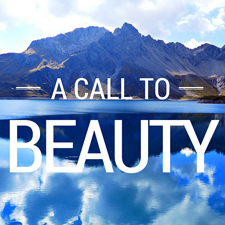Today is World Elephant Day. Because elephants are my favorite animals, today I’m asking you to join me in learning more about significant threats to these majestic creatures and in supporting preservation efforts.
.png) About Elephants
About Elephants
There are two species of elephant, African and Asian. Although similar in appearance, they are too dissimilar biologically to interbreed. Both species are severely threatened, with Asian elephants considered endangered and African elephants threatened.
Habitat loss due to climate change and deforestation, human-elephant conflict, and poaching are all contributing to a sharp decline in the elephant population.
I may have mentioned poaching last but it has had a tremendous impact—poachers slaughtered more than 20,000 African elephants in 2013 according to the Secretariat of the Convention on International Trade in Endangered Species of Wild Fauna and Flora (CITES), and some sources estimate the total at more than 35,000 elephant deaths.
Why World Elephant Day?
World Elephant Day was launched in 2012 “to bring attention to the urgent plight of Asian and African elephants.” As the founders state, “The elephant is loved, revered and respected by people and cultures around the world, yet we balance on the brink of seeing the last of this magnificent creature.”
In 2008, conservation researchers warned that African elephants may be extinct by 2020. Recent reports suggest nothing has changed to improve that estimate; wild African elephants could be a memory just six years from now—for all of the reasons listed above but, most dire, poaching.
National Geographic reports, “In January 2012 a hundred raiders on horseback charged out of Chad into Cameroon’s Bouba Ndjidah National Park, slaughtering hundreds of elephants—entire families—in one of the worst concentrated killings since a global ivory trade ban was adopted in 1989… Elephant poaching levels are currently at their worst in a decade, and seizures of illegal ivory are at their highest level in years.”
The situation is now so dire that I believe it is up to every one of us to become informed about this situation. And sadly many people don’t seem to be listening.
To begin your education, watch this video produced by the David Sheldrick Wildlife Trust in Kenya:

A customer, left, shops for ivory bracelets at an ivory shop in Nakhon Sawan province, 130 miles north of Bangkok, Thailand, April 17, 2002.
There is a lot of misinformation about ivory. IFAW reports that “many ivory buyers are unaware of the cruelty and conservation impacts of poaching elephants.” And poachers pray on consumer ignorance, perpetuating myths such as:
- Ivory comes from elephant teeth, which fall out naturally and are replaced by new growth.
- Ivory is only taken from elephants who have been killed by African families for meat.
- Ivory is procured by removing only the ends of the tusks after elephants are tranquilized.
None of this is true. Poachers get most ivory by killing elephants and hacking off their tusks at the skull.
Take a few moments to think about the heinous act of killing an elephant purely for its tusks, hacking them out of its skull, and leaving the rotting corpse behind. Both male and female African elephants have tusks, unlike Asian elephants, and so this crime is harming entire herds of elephants and decimating the species at large.

A rotting elephant carcass in Hwange National Park, Zimbabwe, after poachers poisoned waterholes with cyanide, Sept. 29, 2013.

In this photo, taken May 21, 2014, Park rangers stand next to the remains of elephants that were killed by poachers in the Garamba National Park, situated in Democratic Republic of Congo.
Jason Bell of IFAW wrote today: “We are fast approaching the tipping point where there won’t be enough time left to make fundamental behaviour [sic] change.” So, let’s join together to do something about this now, before it’s too late!
How You Can Help
As a friend of a friend, entrepreneur Bud Wilson, recently shared on Facebook:
“It is very simple. Humans must learn that we are all part of an extremely beautiful and delicate web of interdependent life. Reverence for all that is human and non-human is the core principle that is missing.”
How can you help?
1. Learn more about the crisis. Here are a few resources to get started:
- “Blood Ivory”, by Bryan Christy for National Geographic, October 2012
- “The Fastest Way To Conservation Is Increasing Literacy,” by Katharine Gammon for Fast Company Co.EXIST, February 21, 2013
- “African Elephants May Be Extinct By 2020 Because People Keep Eating With Ivory Chopsticks,” by Dominique Mosbergen for Huffington Post, July 30, 2014
- Elephants and Ivory: Understanding the Poaching Crisis by The Nature Conservancy
- Protecting Elephants by International Fund for Animal Welfare
2. Pledge to save elephants with IFAW and/or sign the iWorry petition to end the ivory trade.
3. Offer your support to organizations working on the front lines:
- David Sheldrick Wildlife Trust, a nonprofit that raises orphaned elephants and founded the iworry campaign. You may gift the team with much-needed supplies, sponsor an elephant orphan (as I have!), wear your support, or any of the other suggestions made on their World Elephant Day web page.
- Big Life Foundation, a nonprofit founded by photographer Nick Brandt. You can donate directly, buy Nick’s fine art photographs, or learn how to help the communities involved.
- International Fund for Animal Welfare
4. Share the truth with others.
Thank you, for your children and your children’s children,

Featured Image Photo Credit: digitalART2 via Compfight cc


















Kate Watson - Thanks for your comment!
Sally Rorer - Thanks, for sharing this important information.